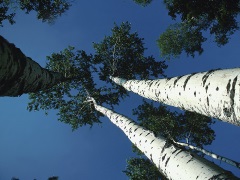Features
The promise of poplars
Date: 2017-01-31 20:53:30.0
Author: Jon Evans

Theoretically, poplar trees are a highly promising biodiesel feedstock. Not only do they grow easily and quickly all over Europe and North America, but poplars are capable of re-growing themselves from their roots after the trunk has been removed, meaning that the same popular tree can be harvested multiple times.
As with any lignocellulosic feedstock, however, there are real practical challenges involved in extracting cellulose from poplar wood and transforming it into fermentable sugars, with lignin the prime obstructive element. As such, scientists have long explored genetic options for reducing or modifying the lignin in poplar trees to make the cellulose easier to extract, but without having a major effect on the trees’ strength or growth.
This work received a boost recently with the release of the largest ever dataset of natural genetic variation in poplar trees. This genetic variation comes in the form of single nucleotide polymorphisms (SNPs), which are places in a gene where one of its component nucleotide bases can vary. Because of SNPs, each gene tends to come in several different versions, known as alleles, across a species. The dataset comprises 28 million SNPs, derived from the genomes of 900 different poplar trees, and was produced by a team led by researchers from Oak Ridge National Laboratory (ORNL) in the US.
These researchers are already using the dataset to identify the molecular mechanisms controlling the deposition of lignin in poplar, in order to develop genetically-modified strains in which that deposition is altered. “We can identify the genes and genetic variants [i.e. alleles] that move carbon through the lignin pathway, and then take that knowledge and, through genomic selection, develop plant materials that are tailored to work with microbes to yield the targeted product,” said Gerald Tuskan at ORNL.
Another recent piece of research, however, shows that simply concentrating on the lignin may not be enough, and might even be detrimental. Conducted by Brigitte Chabbert and her colleagues at the University of Reims in France, this research investigated the effectiveness of three different pre-treatment process at breaking down poplar wood to make the cellulose more accessible to digesting enzymes. The three different pre-treatment processes were: hydrothermal treatment; acid treatment; and aqueous ammonia treatment.
To determine the effect of these processes on accessibility, Chabbert and her team employed a technique known as fluorescence recovery after photobleaching (FRAP). This involves introducing a fluorescent probe into the treated wood and then exposing one small area of the wood to intense illumination to extinguish the probes, turning the area dark. The idea then is simply to record how long it takes for new probes to diffuse into the dark area, with the length of time indicating the accessibility.
To make this technique relevant for the cellulases and xylanases usually used to digest cellulose, Chabbert and her team attached fluorescent probes to two branched molecules known as dextrans – one larger, one smaller – that covered the range of sizes of the enzymes. As the researchers report in Biotechnology for Biofuels, hydrothermal treatment proved most effective at improving the accessibility of poplar wood, even though acid treatment actually removed more lignin.
Investigating this intriguing finding in more detail, the researchers discovered that without the support provided by lignin the cellulose and hemicellulose tended to collapse on top of each other, preventing any major increase in accessibility. Rather than removing all the lignin, a more effective strategy appeared to be to remove some of the lignin and some of the hemicellulose, which is what happens with hydrothermal treatment.
This finding could still prove of use for scientists working with the SNP dataset, as it indicates they should try developing genetically-modified poplar strains with reduced lignin and hemicellulose, rather than just lignin. At least theoretically.
The views represented here are solely those of the author and do not necessarily represent those of John Wiley and Sons, Ltd. or of the SCI.
Displaying 3 keywords used to tag this article:
- 123.25.24.60.52.002 Replica Omega W
- New Design New Balance ML574XBK Cam
- Roger Vivier Cut-out leather light
